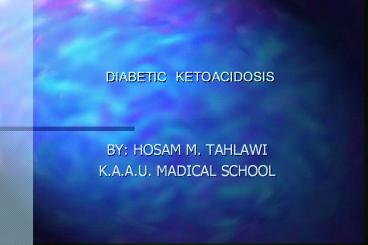DIABETIC KETOACIDOSIS - PowerPoint PPT Presentation
1 / 17
Title:
DIABETIC KETOACIDOSIS
Description:
DIABETIC KETOACIDOSIS BY: HOSAM M. TAHLAWI K.A.A.U. MADICAL SCHOOL Diabetic Ketoacidosis an acute, life threatening metabolic acidosis complicating IDDM and some ... – PowerPoint PPT presentation
Number of Views:718
Avg rating:3.0/5.0
Title: DIABETIC KETOACIDOSIS
1
DIABETIC KETOACIDOSIS
- BY HOSAM M. TAHLAWI
- K.A.A.U. MADICAL SCHOOL
2
Diabetic Ketoacidosis
- an acute, life threatening metabolic acidosis
complicating IDDM and some cases of NIDDM with
intercurrent illness (infection or surgery) - usually coupled with an increase in glucagon
concentration with two metabolic consequences - 1) Maximal gluconeogenesis with impaired
peripheral utilization of glucose - 2) activation of the ketogenic process and
development of metabolic acidosis.
3
Gluconeogenesis
- Maximal gluconeogenesis occurs as glucagon lowers
the concentration of F2,6-bisphosphate which is
the intermediate that activate glycolysis and
inhibit gluconeogenesis. - This results in hyperglycemia and osmotic
diuresis with a resultant dehydration
characteristic of DKA.
4
Ketogenesis
- KETOGENESIS occurs as a results of high
glucagon/insulin ratio - 1) increased liberation of free fatty acids due
to the loss of the inhibitory action of insulin
on the hormone sensitive lipase. - 2) activation of the transport system (or
reestrification to VLDL will occur and nothing
will happen) - this results in high levels of acetone,
acetoacetate and ?-hydroxybutyrate .
5
Clinical Presentation
- anorexia, N/V, along with polydepsia and polyuria
for about 24 hrs. followed by stupor (or coma). - Abdominal pain and tenderness could be present
(remember DDx of acute abdomen). - Kussmaul breathing with fruity odor acetone
- Sings of dehydration (? HR, postural BP, etc.)
- normal or low temperature NB. if fever is
present it suggests infection while leukocytosis
alone is not because DKA per se can cause fever.
6
- Initial lab result in DKA (series) in mmol/l
glucose 26-41 sodium 132 potass
ium 4.8-6.0 bicarbonate 6.0-
10 BUN 9.0-15 - acetoacetate 4.8 ?-hydroxybutyrate
13.7 free fatty acid 2.1-2.3 lactate
4.6 osmolality 310-331 - osmolality 2(NaK) Glu BUN
7
- Sources of acid include acetoacetate and BHB
along with lactate, FFA, PO4 - Sodium is low due to dilutional effect of
shifting of fluid to the ECF. - Sodium leveld below 110 mmol/L suggest either
- vomiting and excessive water drinking
- interference by hypertriglyceridemia
8
- Initial potassium could be normal or high but
this is misleading since there is a huge
total-body potassium deficit. - Prerenal azotemia is a reflection of the volume
depletion. - Serum amylase might be elevated and frank
pancreatitis can occur.
9
- Diagnosis of DKA in IDDM patient is not that
difficult. - The problem is pointing towards the cause of
acidosis with anion gap in a person who is not
known diabetic. - Causes to consider 1) lactic acidosis. 2)
uremia. 3) alcoholic ketoaciosis (see
later) 4) certain poisonings.
10
- The initial step in diagnostic approach is
testing urine for glucose and ketones. - Diagnostic criteria for DKA
- hyperglycemia (gt250 mg/dl)
- ketosis (ketonemia or ketonuria)
- acidosis (pHlt7.3, HCO3lt15mEq/L)
- supporting features are volume depletion and
Kussmauls breathing.
11
Diabetic Vs. Alcoholic Ketoacidosis
- by definition AKA occurs in chronic alcoholism
especially after a binge drinking!? - always occurs with starvation.
- sever abdominal pain and tenderness and
pancreatitis occur in 75. - 90 presents with glucose level lt150 mg/dl
- rapidly reversed with IV glucose, but remember to
give thiamin to avoid Beriberi
12
- Insulin is a prerequisite for recovery
- preferable way is to give 25-50U as an initial IV
bolus (or IM) followed by infusion of 15-25U/hour
till ketosis is reversed. - IGF-1 is used in insulin resistance
- IVF the usual fluid deficit is 3-5L
- on arrival the patient is given 1-2L of isotonic
saline or ringers lactate followed by infusion
rates dependent on fluid status and urine output. - when glucose reaches 300mg/dl add 5 glucose
solution (? cerebral Edema)
13
- Potassium replacement is always necessary
- if value on arrival is high delay replacement
till reversal of ketosis - if values are low give K early
- if values are very low hold insulin for 60-90
min. till 40-50 mmol of K are given - bicarbonate
- indicated in sever acidosis (pH 7.0 or below) or
with hypotension (that can be caused by acidosis
alone) - stop the infusion at pH 7.2 to avoid alkalosis
upon reversal of ketosis.
14
THERAPUTIC CONSIDERATIONS
- 1) Plasma glucose will invariably fall more
rapidly than ketones. So, dont stop insulin
unless reversal of ketosis occur. - 2) plasma ketones are not very helpful in
assessing clinical response. So use the pH and
anion gap instead. AG (NaK) - (ClHCO3)
15
- ALL patients should be followed with a flow sheet
outlining amounts and timing of insulin and
fluids together with record of vital signs, urine
volume, and blood chemistries. Without such a
record therapy tends to be chaotic. - Patients are not doctors so we have to make sure
that each patient receives intensive detailed
instructions about how to avoid this potentially
disastrous complication of diabetes mellitus.
16
Complications of DKA and clues to their
development
- Acute gastric dilatation or erosive gastritis
- by vomiting blood or coffee-ground material
- Cerebral edema
- obtundation or coma with or without neuro.
Signs, especially if occurring with initial
improvement. - Hyperkalemia cardiac arrest
- hypokalemia cardiac arrythmias.
- Infection is known by fever
- hypoglycemia is considered when there is
adrenergic or neuorologic signs or rebound
ketosis.
17
- Insulin resistance unremitting acidosis after
4-6 hrs of Rx - MI chest pain, appearance of HF, hypotension
despite adequate fluids. - Mucormycosis facial pain, bloody nasal
discharge, blurred vision, proptosis. - ARDS hypoxemia in absence of pneumonia, COPD,
or HF - Vascular thrombosis stroke-like picture or
signs of ischemia in nonnervous tissue.































